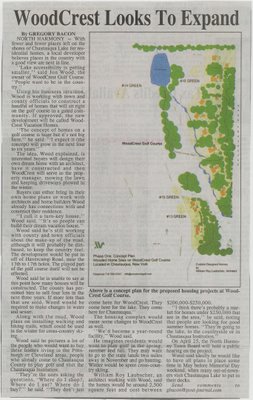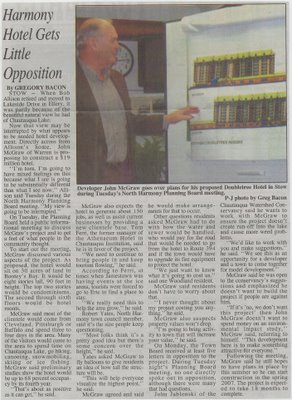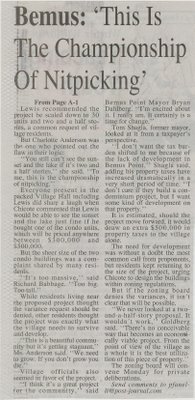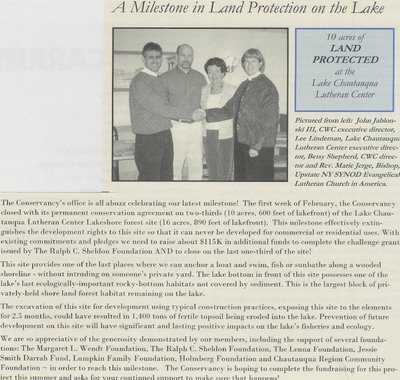Riptide in boat tragedy's wakeUndercurrent of inequity roils regulatory waters as state seeks to elevate safety on passenger vesselsBy TOM PRECIOUS and MAKI BECKER News Staff Reporters3/13/2006
Charles Lewis/Buffalo NewsRick Deegan, who operates the Dragon Lady tour boat off Grand Island, expects that his business is probably "a year or two away" from being subject to Coast Guard regulations similiar to those the state wants to impose onlandlocked lake boats.
When the Ethan Allen tour boat capsized on Lake George last October, killing 20 elderly passengers, the state's tour boat owners knew they soon would face new regulations.
As promised, Gov. George E. Pataki recently proposed legislation to toughen passenger boat safety standards and establish minimum insurance requirements.
But because of a quirk in maritime law, the standards can only apply to tour boats operated on landlocked bodies of water within the state.
So Rick Willman, who owns the Summer Wind, a 130-passenger party boat on Chautauqua Lake, soon may have to pay triple his current insurance premium to continue to operate his business.
But the Miss Buffalo in the Erie Basin Marina and the world-famous Maid of the Mist at the base of Niagara Falls won't see any rule changes.
The reason: Vessels on waters that in some way, however remotely, connect to the Great Lakes or the Atlantic Ocean are policed by the Coast Guard.
"It's just that we can get to the ocean, and they can't," said Michael R. Hayhurst, president of Buffalo Charters, who operates the Miss Buffalo and the Niagara Clipper during the summer with his two brothers.
Both of Hayhurst's tour boats are insured, as are Maid of the Mist's vessels, their owners said.
When the Ethan Allen capsized last fall, the victims' family members were stunned to learn that neither the state nor the Coast Guard required tour boats to carry liability insurance. The Ethan Allen did have $2 million in insurance, but the policy did not include accidents that happened on the water, leaving survivors with no one to sue to cover funerals and other costs.
"We felt after this incident occurring in October that a minimum amount of insurance was certainly something that was necessary to protect the boat-going public," said Paul J. Laudato, chief counsel for the state Department of Parks, Recreation and Historic Preservation.
Boat operators were prepared for intensified scrutiny of their industry and new regulations after the Ethan Allen tragedy - and many say they welcome Pataki's call for stricter safety regulations.
But the insurance coverage mandate has rattled operators of both landlocked and Coast Guard-inspected vessels.
"I've been talking to a lot of my clients and talking to a lot of legislators," said Peter Robinson, a boating insurance agent in Hudson Falls.
"They don't want to have to pay so much insurance to operate," he said.
"I think it's going to put a lot of people out of business," said Willman, who expects that the insurance bill on his 8-year-old boat will be at least three times higher. "It's a clear-cut case of discrimination."
Some tour operators overseen by the Coast Guard think they, too, will be affected eventually.
"I don't think we're more than a year or two away from some significant Coast Guard regulations that are going to basically say the same thing," said Rick Deegan, who operates the Dragon Lady off Grand Island.
Most tour boats, whether registered with the state or the Coast Guard, already are insured, according to a state boating trade group.
But operators of tour boats in the state's landlocked lakes, such as Chautauqua, say the governor has failed to consider the economic impact of his minimum insurance requirements, which would be $10 million per vessel for boats with more than 100 passengers.
Willman said insurance requirements are especially tough on seasonal businesses such as his where every day and dollar counts. "We're not living in Florida or a Southern area where they can boat 12 months a year," Willman said. "We get eight to 12 weeks, and we're over and done with."
Already facing higher costs, including fuel, a big increase in insurance premiums would be unaffordable for companies operating on tight margins, the boaters said.
"It's a bit of an overkill," said Jim Loutzenhiser, president of Chautauqua Lake Historic Vessels, which runs the Chautauqua Belle steam paddle wheel and a chain ferry on the lake. Nonprofit groups such as his would be especially hard-hit, he said.
"To see the Belle not run would be a real tragedy," said Loutzenhiser, who gets no pay when he captains the 120-passenger boat for summer campers and church groups.
All of the governor's proposed requirements, Laudato said, are aimed at passenger safety.
"They get on these vessels assuming they will be safe, and if there is an accident, there must be a way to address any injuries or property damage that results from the accident," he said.
But Hayhurst questioned whether the added insurance costs could actually prove to be dangerous.
"Putting some onerous cost on a boat operator may have a negative effect on safety," Hayhurst said. "Somewhere, he's got to save $10,000 to make up for that. Is he going to take it out of cutting corners on safety?"
The governor's bill has already been greeted with some concern in the State Legislature.
"I think we have to moderate it somewhat," said State Sen. Betty Little, a Republican who represents the Lake George area. She said that there needs to be a balance to protect the public while not forcing boat operators to shut down.
Little submitted a bill last month that would require passenger vessels on state-regulated waters to have a minimum of $1 million worth of insurance coverage.
"You ride a boat and you ought to be confident they have insurance," she said.
Little said the state probably could require all boats - including those regulated by the Coast Guard - to have insurance. But state regulation of those boats would be difficult, she said.
Beyond new insurance mandates, the governor's bill also would:
• Require a means of communications on each tour boat.
• Require an approved emergency plan that would include notifying emergency personnel on shore about an accident.
• Outlaw operation of a vessel with fewer crew members than specified.
• Require at least two exits per deck for boats carrying 20 or more passengers.
The new bill follows legislation Pataki submitted last fall that would require operators to undergo an immediate chemical test for drugs or alcohol after an accident in which passengers are killed or severely injured.
For more information on Chautauqua Lake Real Estate & Living visit:
www.chautauqualakehomes.com
















